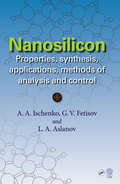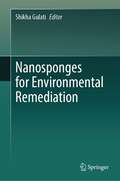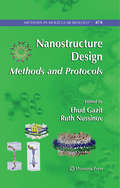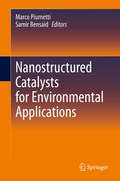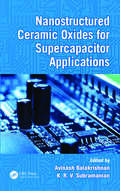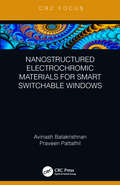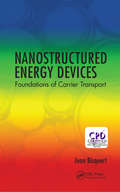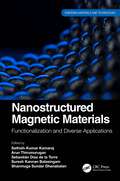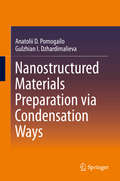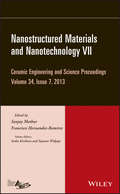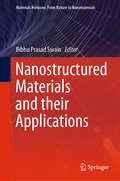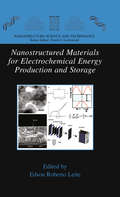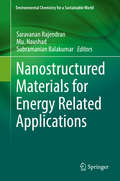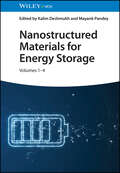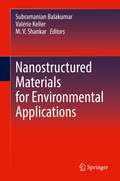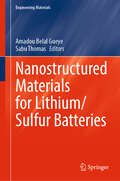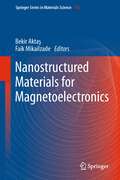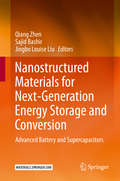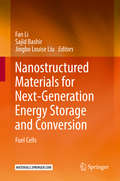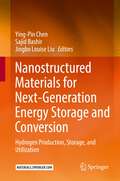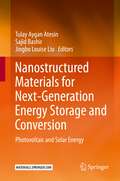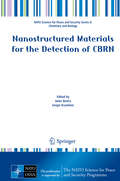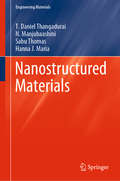- Table View
- List View
Nanosilicon: Properties, Synthesis, Applications, Methods of Analysis and Control
by Anatoly A. Ischenko Gennady V. Fetisov Leonid A. AslalnovNanosilicon: Properties, Synthesis, Applications, Methods of Analysis and Control examines the latest developments on the physics and chemistry of nanosilicon. The book focuses on methods for producing nanosilicon, its electronic and optical properties, research methods to characterize its spectral and structural properties, and its possible applic
Nanosponges for Environmental Remediation
by Shikha GulatiThe book covers the chemistry of various nanosponges, as well as the methods for synthesizing them and altering them chemically, as well as their characterization and uses in environmental remediation. Sensors, adaptable materials for oil clean-up in the sea, the removal of dangerous organic and inorganic pollutants from wastewater, the adsorption of various poisonous and greenhouse gases from the air, and more are just a few of the environmental uses for nanosponges. This book aims to provide broad coverage of recent research progress or up-to-date knowledge addressing various aspects in this field. With this book, we aim to provide the readers with the opportunity to learn about different facets of environmental remediation using nanosponges. Thus, this book scrutinizes the state-of-the-art research and discovery in the use of nanosponges in environmental applications, highlighting the scope to which these novel materials have been incorporated by the community. Beyond bestowing a summary of recent research by major groups in the field, the book presents the approaches behind recent developments, providing a long-lasting situation for experienced researchers and novices in the field. This book also emphasizes the challenges with previous signs of progress and way for further research, details relating to the current pioneering technology, and future perspectives with a multidisciplinary approach. Furthermore, it presents up-to-date information on the economics, toxicity, and regulations related to these novel materials. This book is of interest to those in environmental science and applications, particularly graduate students, young faculty, and others exploring nanosponges.
Nanostructure Design
by Ehud Gazit Ruth NussinovAs one of the fastest growing fields of research in the 21st century, nanotechnology is sure to have an enormous impact on many aspects of our lives. Nanostructure Design: Methods and Protocols serves as a major reference for theoretical and experimental considerations in the design of biological and bio-inspired building blocks, the physical characterization of the formed structures, and the development of their technical applications. The chapters contributed by leading experts are divided into two sections, the first of which covers experimental aspects of nanostructure design and the second delves into computational methods. As a volume of the highly successful Methods in Molecular BiologyTM series, this collection pulls together cutting-edge protocols, written in a step-by-step, readily reproducible format certain to guide researchers to the desired results. Comprehensive and essential, Nanostructure Design: Methods and Protocols uses biological principles and vehicles on design to aid scientists in the great challenges still ahead.
Nanostructure Semiconductor Optical Amplifiers
by Hamed Baghban Ali Rostami Reza Maram"Nanostructure Semiconductor Optical Amplifiers" reviews all-optical processing methods currently available and presents semiconductor optical amplifiers (SOAs) as a new building block for this purpose. The authors discuss the overcomes of high frequency operation of SOAs and propose a new all-optical pumping method for the implementation of semiconductor optical amplifiers.
Nanostructured Catalysts for Environmental Applications
by Marco Piumetti Samir BensaidThis book offers an overview of the recent studies and advances in environmental catalysis by nanomaterials, considering both the fundamental and the technological aspects. It offers contributions in different areas of environmental catalysis, including the catalytic and photocatalytic abatement of environmentally hazardous effluents from stationary or mobile sources, the valorization of waste and the production of sustainable energy. In other words, this monograph provides an overview of modern environmental and energy related applications with a particular emphasis to nano-sized catalytic materials. Recent concepts, experimental data and advanced theories are reported in this book to give evidence of the environmental and sustainable applications that can be found in the highly interdisciplinary field of catalysis.
Nanostructured Ceramic Oxides for Supercapacitor Applications
by Avinash Balakrishnan K. R. V. SubramanianA fresh and innovative technology is currently being recognized as a viable replacement for batteries. Research in the field of supercapacitors, as well as in the area of ceramic materials and their application to supercapacitor development, has spawned Nanostructured Ceramic Oxides for Supercapacitor Applications. Featuring key contributions from
Nanostructured Electrochromic Materials for Smart Switchable Windows
by Avinash Balakrishnan Praveen PattathilThis book focuses on next-generation smart windows which can change their optical-physical properties by reflecting and/or transmitting incoming light radiation to attain comfortable indoor temperatures throughout the year. Offers in-depth discussion of a range of materials and devices related to different technologies used in manufacturing smart windows Discusses basic principles, materials synthesis and thin film fabrication, and optical and electrochemical characterization techniques
Nanostructured Energy Devices: Foundations of Carrier Transport
by Juan BisquertThe second volume, Foundations of Carrier Transport, presents a catalogue of the physics of carrier transport in semiconductors with a view to energy device models. We systematically explain the diffusion-drift model that is central to solar cell operation, the different responses of band bending and electrical field distribution that occur when a voltage is applied to a device with contacts and the central issue of injection and mechanisms of contacts. We describe the carrier transport in disordered materials that often appear as good candidates for easily processed solar cells. There are also excursions into other important topics such as the transistor configuration and the frequency domain techniques as Impedance Spectroscopy that produce central experimental tools for the characterization of the devices.
Nanostructured Magnetic Materials: Functionalization and Diverse Applications (Emerging Materials and Technologies)
by Sathish-Kumar Kamaraj Arun Thirumurugan Shanmuga Sundar Dhanabalan Suresh Kannan Balasingam Sebastián Díaz de la TorreFunctionalized magnetic nanomaterials are used in data storage, biomedical, environmental, and heterogeneous catalysis applications but there remain developmental challenges to overcome. Nanostructured Magnetic Materials: Functionalization and Diverse Applications covers different synthesis methods for magnetic nanomaterials and their functionalization strategies and highlights recent progress, opportunities, and challenges to utilizing these materials in real-time applications. • Reviews recent progress made in the surface functionalization of magnetic nanoparticles. • Discusses physico-chemical characterization and synthesis techniques. • Presents the effect of the external magnetic field. • Details biological, energy, and environmental applications as well as future directions. This reference will appeal to researchers, professionals, and advanced students in materials science and engineering and related fields.
Nanostructured Materials Preparation via Condensation Ways
by Anatolii D. Pomogailo Gulzhian I. DzhardimalievaThe book is devoted to novel nanostructured materials and nanotechnology. A comprehensive analysis of the condensing methods of preparation of novel nanostructured materials is given. The methodology of power-consuming preparation of nanostructured materials is discussed, including thermolysis, photo- and radiolytic, electrochemical and mechanochemical methods. The peculiarities of chemical transformations in organic and inorganic matrices are compared. Special attention is given to kinetics and mechanism of the formation of nanocomposites. The structure and properties of such nanostructured materials are analysed.
Nanostructured Materials and Nanotechnology VII
by Sanjay Mathur Soshu Kirihara Sujanto Widjaja Francisco Hernandez-RamirezCeramic Engineering and Science Proceedings Volume 34, Issue 7 - Nanostructured Materials and Nanotechnology VII A collection of 15 papers from The American Ceramic Society’s 37th International Conference on Advanced Ceramics and Composites, held in Daytona Beach, Florida, January 27-February 1, 2013. This issue includes papers presented in the 7th International Symposium on Nanostructured Materials and Nanotechnology (Symposium 7) and Nanomaterials for Sensing Applications symposia (Focused Session 3).
Nanostructured Materials and their Applications (Materials Horizons: From Nature to Nanomaterials)
by Bibhu Prasad SwainThe book provides an introduction to nanostructured materials and guides the reader through their different engineering applications. It gives an overview of nanostructured materials applied in the fields of physics, chemistry, biology, medicine, and materials science. Materials for different applications in engineering such as those used in opto-electronics, energy, tribology, bio-applications, catalysis, reinforcement and many more have been described in this book. The book will be of interest to researchers and students who want to learn about applications of nanostructured materials in engineering.
Nanostructured Materials for Electrochemical Energy Production and Storage
by Edson Roberto LeiteThe key problem facing new energy conversion and storage technologies remains device efficiency. Designs based on nanostructured materials can yield improved performance in devices employing electrochemical reactions and heterogeneous catalysis, such as fuel and solar cells, batteries, etc. Nanoscale structures dramatically alter the surface reaction rates and electrical transport throughout the material, causing a dramatic improvement in energy storage, conversion, and generation. This book describes properties of nanostructured materials that can be the basis of improved performance in a wide range of alternative energy devices. Fundamental concepts of nanostructured materials such as nanocrystals synthesis and properties, thermodynamics and defect chemistry, and interfacial and physical electrochemistry are presented as are the impact and application of nanoscale materials in specific alternative energy devices. These materials and devices promise not only the development of a wide range of new technologies, but also the potential for a more sustainable energy future. Nanostructured Materials for Electrochemical Energy Production and Storage is an authoritative and essential reference from world-renowned research groups for scientists and engineers in the fields of materials science and electrochemistry.
Nanostructured Materials for Electronic Nose (Advanced Structured Materials #213)
by Nirav J. Joshi Sachin NavaleThis book presents recent developments and fascinating attributes of electronic-nose (E-nose) technology based on advanced nanostructured materials that are compatible with modern semiconductor fabrication technology. The new trend in these nanostructured materials includes metal oxide nanostructures, 2D materials, graphene, and other carbon-based nanostructures. These versatile materials with remarkable electronic, mechanical, electrical, thermal properties, and potential e-nose in a wide range of fields are discussed in the book. Close attention is given to problems connected with stability, selectivity, and functionalizing of e-nose devices and deposited materials. The field of sensors is indeed in fast and consistent growth. This book consolidates information on each and every aspect of these novel materials, their gas sensing mechanisms, engineering, and e-nose devices covering the entire spectrum of up-to-date literature citations, current market, and patents in a very detailed manner. Moreover, in the past few years, tremendous advances have been made in experimental and theoretical studies on various properties of these materials. In summary, this book makes an attempt to provide in-depth study of recent advances and focuses on current problems related to selectivity and stability of sensor devices. The book is interesting to all materials professionals and researchers from universities and national laboratories working in the field of nanostructured materials-based gas sensors.
Nanostructured Materials for Energy Related Applications (Environmental Chemistry for a Sustainable World #24)
by Mu. Naushad Saravanan Rajendran Subramanian BalakumarThis book describes the role and fundamental aspects of the diverse ranges of nanostructured materials for energy applications in a comprehensive manner. Advanced nanomaterial is an important and interdisciplinary field which includes science and technology. This work thus gives the reader an in depth analysis focussed on particular nanomaterials and systems applicable for technologies such as clean fuel, hydrogen generation, absorption and storage, supercapacitors, battery applications and more. Furthermore, it not only aims to exploit certain nanomaterials for technology transfer, but also exploits a wide knowledge on avenues such as biomass-derived nanomaterials, carbon dioxide conversions into renewable fuel chemicals using nanomaterials. These are the areas with lacunae that demand more research and application.
Nanostructured Materials for Energy Storage
by Kalim Deshmukh Mayank PandeyComprehensive reference work for researchers and engineers working with advanced and emerging nanostructured battery and supercapacitor materials Lithium-ion batteries and supercapacitors play a vital role in the paradigm shift towards sustainable energy technology. This book reviews how and why different nanostructured materials improve the performance and stability of batteries and capacitors. Sample materials covered throughout the work include: Graphene, carbon nanotubes, and carbon nanofibers MXenes, hexagonal boron nitride, and transition metal dichalcogenides Transition metal oxides, metal-organic frameworks, and lithium titanates Gel polymer electrolytes, hydrogels, and conducting polymer nanocomposites For materials scientists, electrochemists, and solid state chemists, this book is an essential reference to understand the lithium-ion battery and supercapacitor applications of nanostructured materials that are most widely used for developing low-cost, rapid, and highly efficient energy storage systems.
Nanostructured Materials for Environmental Applications
by Subramanian Balakumar Valérie Keller M. V. ShankarThis book discusses how nanostructured materials play a key role in helping address environmental challenges. Employing nanostructured materials in catalysis can increase the efficient decomposition of toxic pollutants in air, water, and soil. This multidisciplinary book discusses the most promising nanostructured materials made-up of metals, metal oxides, metal chalcogenides, multi-metal oxides, carbon nanostructures, and hybrid materials that can address environmental remediation. It provides a well-referenced introduction to newcomers from allied disciplines and will be valuable to researchers in academia, industry, and government working on solutions to environmental problems.
Nanostructured Materials for Lithium/Sulfur Batteries (Engineering Materials)
by Sabu Thomas Amadou Belal GueyeThis book delves into the key aspects of lithium/sulfur batteries, exploring their electrochemistry, reaction mechanisms, disadvantages, and characterization methods. It highlights recent advances in designing nanostructured electrode materials, including various carbon-host materials, polymer-derived materials, binder-free sulfur-hosts, and metal oxides. The impact of these nanostructures on battery properties such as capacitance, rate capability, and cycle stability is discussed, providing guidelines for future electrode design. The book also reviews the progress in electrolytes and the development of advanced separators, such as functionalized polyolefins, carbon-metal oxide hybrids, and electrospun materials, and presents the future outlook and challenges in this field.
Nanostructured Materials for Magnetoelectronics
by Bekir Aktas Faik MikailzadeThis book provides an up-to-date review of nanometer-scale magnetism and focuses on the investigation of the basic properties of magnetic nanostructures. It describes a wide range of physical aspects together with theoretical and experimental methods. A broad overview of the latest developments in this emerging and fascinating field of nanostructured materials is given with emphasis on the practical understanding and operation of submicron devices based on nanostructured magnetic materials.
Nanostructured Materials for Next-Generation Energy Storage and Conversion: Advanced Battery and Supercapacitors
by Sajid Bashir Jingbo Louise Liu Qiang ZhenVolume 3 of a 4-volume series is a concise, authoritative and an eminently readable and enjoyable experience related to lithium ion battery design, characterization and usage for portable and stationary power. Although the major focus is on lithium metal oxides or transition metal oxide as alloys, the discussion of fossil fuels is also presented where appropriate. This monograph is written by recognized experts in the field, and is both timely and appropriate as this decade will see application of lithium as an energy carrier, for example in the transportation sector.This Volume focuses on the fundamentals related to batteries using the latest research in the field of battery physics, chemistry, and electrochemistry. The research summarised in this book by leading experts is laid out in an easy-to-understand format to enable the layperson to grasp the essence of the technology, its pitfalls and current challenges in high-power Lithium battery research. After introductory remarks on policy and battery safety, a series of monographs are offered related to fundamentals of lithium batteries, including, theoretical modeling, simulation and experimental techniques used to characterize electrode materials, both at the material composition, and also at the device level. The different properties specific to each component of the batteries are discussed in order to offer tradeoffs between power and energy density, energy cycling, safety and where appropriate end-of-life disposal. Parameters affecting battery performance and cost, longevity using newer metal oxides, different electrolytes are also reviewed in the context of safety concerns and in relation to the solid-electrolyte interface. Separators, membranes, solid-state electrolytes, and electrolyte additives are also reviewed in light of safety, recycling, and high energy endurance issues. The book is intended for a wide audience, such as scientists who are new to the field, practitioners, as well as students in the STEM and STEP fields, as well as students working on batteries. The sections on safety and policy would be of great interest to engineers and technologists who want to obtain a solid grounding in the fundamentals of battery science arising from the interaction of electrochemistry, solid-state materials science, surfaces, and interfaces.
Nanostructured Materials for Next-Generation Energy Storage and Conversion: Hydrogen Production, Storage, And Utilization
by Sajid Bashir Jingbo Louise Liu Fan LiThe energy crisis and pollution have posed significant risks to the environment, transportation, and economy over the last century. Thus, green energy becomes one of the critical global technologies and the use of nanomaterials in these technologies is an important and active research area. This book series presents the progress and opportunities in green energy sustainability. Developments in nanoscaled electrocatalysts, solid oxide and proton exchange membrane fuel cells, lithium ion batteries, and photovoltaic techniques comprise the area of energy storage and conversion. Developments in carbon dioxide (CO2) capture and hydrogen (H2) storage using tunable structured materials are discussed. Design and characterization of new nanoscaled materials with controllable particle size, structure, shape, porosity and band gap to enhance next generation energy systems are also included.The technical topics covered in this series are metal organic frameworks, nanoparticles, nanocomposites, proton exchange membrane fuel cell catalysts, solid oxide fuel cell electrode design, trapping of carbon dioxide, and hydrogen gas storage.
Nanostructured Materials for Next-Generation Energy Storage and Conversion: Hydrogen Production, Storage, and Utilization
by Ying-Pin Chen Sajid Bashir Jingbo Louise LiuVolume 1 of a 4-volume series is a concise, authoritative and an eminently readable and enjoyable experience related to hydrogen production, storage and usage for portable and stationary power. Although the major focus is on hydrogen, discussion of fossil fuels and nuclear power is also presented where appropriate. This monograph is written by recognized experts in the field, and is both timely and appropriate as this decade will see application of hydrogen as an energy carrier, for example in transportation sector. The world's reliance on fossil fuels is due to the ever growing need for energy to sustain life and on-going progress; however exploitation also brings consequences such as emission of carbon, nitrogen and sulfur dioxides into the atmosphere. The collective influence of these photochemical gases is production of acid rain and an alternation of global temperatures, leading to record high temperatures in many parts of the world. The fossil fuel is unsustainable and thus there is a critical need for alternative sustainable energy resources. One universal energy carrier is hydrogen, which is the focus of this volume. This book is suitable for those who work in the energy field as technical experts, including engineers and scientists, as well as managers, policy and decision-makers, environmentalists and consultants. Students and practitioners such as lectures, teachers, legislators and their aids in the field of energy will find this book invaluable and a practical handbook or guide in the field of sustainable energy with emphasis on hydrogen as an energy carrier.
Nanostructured Materials for Next-Generation Energy Storage and Conversion: Photovoltaic and Solar Energy
by Sajid Bashir Jingbo Louise Liu Tulay Aygan AtesinNanostructured Materials for Next-Generation Energy Storage and Conversion: Photovoltaic and Solar Energy, is volume 4 of a 4-volume series on sustainable energy. Photovoltaic and Solar Energy while being a comprehensive reference work, is written with minimal jargon related to various aspects of solar energy and energy policies. It is authored by leading experts in the field, and lays out theory, practice, and simulation studies related to solar energy and allied applications including policy, economic and technological challenges. Topics covered include: introduction to solar energy, fundamentals of solar radiation, heat transfer, thermal collection and conversion, solar economy, heating, cooling, dehumidification systems, power and process heat, solar power conversion, policy and applications pertinent to solar energy as viable alternatives to fossil fuels. The aim of the book is to present all the information necessary for the design and analysis of solar energy systems for engineers, material scientists, economics, policy analysts, graduate students, senior undergraduates, solar energy practitioner, as well as policy or lawmakers in the field of energy policy, international energy trade, and libraries which house technical handbooks related to energy, energy policy and applications.
Nanostructured Materials for the Detection of CBRN (NATO Science for Peace and Security Series A: Chemistry and Biology)
by Janez Bonča Sergei KruchininThis book includes topics in nanophysics, nanotechnology, nanomaterials, sensors, biosensors, security systems, and CBRN agents detection. There have been many significant advances in the past two years and some entirely new directions of research are just opening up. Recent developments in nanotechnology and measurement techniques now allow experimental investigation of the physical properties of nanostructured materials. The book presents new methods for the detection of chemical, biological, radiological and nuclear (CBRN) agents using chemical and biochemical sensors. Identification, protection and decontamination are the main scientific and technological responses for the modern challenges of CBRN agents.
Nanostructured Materials: Synthesis, Properties, And Advanced Applications (Engineering Materials)
by Sabu Thomas T. Daniel Thangadurai N. Manjubaashini Hanna J. MariaThis book discusses the early stages of the development of nanostructures, including synthesis techniques, growth mechanisms, the physics and chemistry of nanostructured materials, various innovative characterization techniques, the need for functionalization and different functionalization methods as well as the various properties of nanostructured materials. It focuses on the applications of nanostructured materials, such as mechanical applications, nanoelectronics and microelectronic devices, nano-optics, nanophotonics and nano-optoelectronics, as well as piezoelectric, agriculture, biomedical and, environmental remediation applications, and anti-microbial and antibacterial properties. Further, it includes a chapter on nanomaterial research developments, highlighting work on the life-cycle analysis of nanostructured materials and toxicity aspects.
